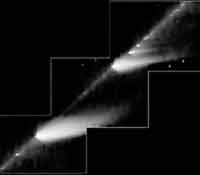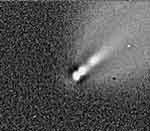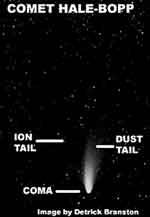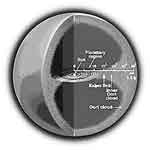| Comets have often been a cause of wonder and beauty to many and astronomers are still unravelling their mysteries |
||||||||||
Dirty crumbling snowballs
The close approach to Earth of a fragmented comet called Schwassmann-Wachmann 3 (hereafter called comet SW3), during mid-May generated worldwide excitement among astronomers and the general public. Such celestial events kindle the natural human curiosity to understand the world around us.
Comet SW3, which has an orbit that nearly intersects with Earth’s orbit, came to within about 10 million km from us (a relatively close distance in cosmic terms). The comet was broken into multiple pieces about ten years back. The close approach to Earth allowed astronomers to have a detailed look at this fragmented object. Indeed it turned out to be a great show. During the coming months, astronomers will analyse the observations of this comet to unravel many mysteries. In this context, we will review the current understanding of comets, and the relevance of studying these celestial wanderers to the human race. What is a comet?
An average cometary nucleus is only a few km across (nominally the size of Colombo city), whereas the coma and the tails can extend up to a few hundred thousand km and few million km, respectively. These large numbers are best understood by comparison to familiar dimensions. If we scale down the nucleus to the size of a potato, then the size of the coma is comparable to the city of Colombo, and the tails could span the length of Sri Lanka. Therefore, the coma of a comet is much larger than the nucleus. In contrast, the Earth’s atmosphere is a thin shell in relation to the size of Earth. Unlike Earth’s atmosphere, the dusty gas environment of the coma (or the tails) is a rarefied medium – almost close to a vacuum. A spacecraft could fly through the coma or the tails of a comet, without experiencing any significant slowing. The dust particles in the coma or in the tail show their presence via reflected sunlight, whereas gas molecules emit light via fluorescence (the same physical mechanism through which a fluorescent light bulb generates light). Thus, the dust tail appears yellow. The plasma tail is blue, because of the strong fluorescence emission of blue light by carbon monoxide ions (CO+). In contrast, the coma of a comet may appear yellow (if the comet is dust rich), or bluish green (if it is gas rich). The coma of a gassy comet appears bluish green, because the dominant emission is by CN and C2 molecules in the blue and green part of the spectrum. Although they may determine the colour, CN and C2 are not the most abundant species. So, what are the most abundant species of a comet? As noted earlier, a cometary nucleus consists of dust and ices. The most abundant ice is water (H2O) ice. In addition, we have ices corresponding to many other species. In 1950, American astronomer Fred Whipple suggested that a comet (or more precisely the comet nucleus) is a conglomeration of ices and dirt. While this ‘dirty snowball model’ of the nucleus withstood subsequent scientific tests, the first direct confirmation was in 1986, when spacecraft obtained clear images of the nucleus of comet Halley. Due to the scientific advances catalysed by his work, many consider Fred Whipple, who died in 2004 at the age of 97, to be the father of modern cometary science. How and where were comets formed?
The largest planet, Jupiter and to a lesser extent
Saturn, Uranus and Neptune were responsible for ‘clearing’
most of the comets and asteroids from the Solar System. The gravitational
forces of these giant planets scattered the comet nuclei that formed
in the giant planet region. Many of the comet nuclei, which were
scattered by giant planets escaped our Solar System altogether.
However, a significant number remained in the outer edges of the
Solar System – a region we call the Oort Cloud, after Dutch
astronomer Jan Oort, who first postulated such a reservoir of comets
nearly fifty six years ago. They suggested the possibility of a belt of comets beyond Neptune in our Solar System. However, it was only in 1992 that the first new object belonging to the Kuiper Belt (also known as the Edgeworth-Kuiper Belt) was discovered. After the discovery of this object, 1992 QB1, by David Jewitt and Jane Luu of University of Hawaii, we now know of nearly 1,000 such objects called Trans-Neptunian Objects (TNOs). With a sufficient number of TNOs discovered, we are beginning to see the structure of the Kuiper Belt. In addition, we now have clear evidence based on the orbits of these TNOs, that planet Pluto is definitely a member of the Kuiper Belt. This leads to the interesting question: should Pluto be called a planet, and if that is the case, should the recently discovered TNO, 2003 UB313 (nicknamed Xena), which by all means is larger than Pluto, be called a planet too? Currently the International Astronomical Union is debating the definition of a ‘planet’. The Kuiper Belt and the Oort Cloud are the two reservoirs of comets. Due to gravitational perturbations, orbits of comets in these reservoirs get changed over many millions of years. This causes some comets to end up with such orbits that make those comets visit the inner Solar System and Earth’s neighbourhood. Space missions to comets
Thus far, there have been a number of missions to comets and four cometary nuclei (Halley, Borrelly, Wild 2, and Tempel 1) were imaged. These images had sufficient resolution to identify basic surface features, and for comparisons between individual nuclei. Interestingly, most nuclei were found to be highly irregular and elongated. The last flyby mission Deep Impact, in addition to taking images and spectra of both the nucleus and the coma, carried out a novel experiment to explore the subsurface material of the nucleus by striking it with a copper impactor and excavating a crater. This general concept is not new. For example, in 2001: A Space Odyssey, Sir Arthur C. Clarke describes a similar experiment on an asteroid. Why do we want to explore the subsurface material? Though comets are the most pristine objects leftover from the formation of the Solar System, the surface layers, especially, are highly evolved due to heat from the sun. Therefore, in order to learn about the more pristine material, one has to look sufficiently interior to the surface. The cometary impact by the Deep Impact spacecraft on July 4, 2005 provided direct evidence that at least the surface layers of the nucleus consist of more dust than we anticipated. It also confirmed what many cometary scientists were suspecting about the density of cometary nuclei based on theoretical work – the comet nucleus is lighter than water ice. The derived density was only half that of water. Considering that the nucleus is made up of dust and ice, what does this mean? Does nucleus contain large porous structures? The Rosetta mission will hopefully provide an answer in 2014, when its radar performs a ‘cat scan’ of comet Churyumov-Gerasimenko. Knowledge of the cometary structure is relevant, not only to understand the environment of the Solar System during its formation phase, but also to devise effective mitigation strategies for killer comets (or asteroids) that could inflict devastation in the case of a collision with Earth.
|
||||||||||
Copyright © 2006 Wijeya Newspapers
Ltd. All rights reserved. |




 After
obtaining an Honours degree in Physics at the University of
Colombo, Dr. Samarasinha did his doctoral research at the University
of Maryland, College Park (USA).
After
obtaining an Honours degree in Physics at the University of
Colombo, Dr. Samarasinha did his doctoral research at the University
of Maryland, College Park (USA).